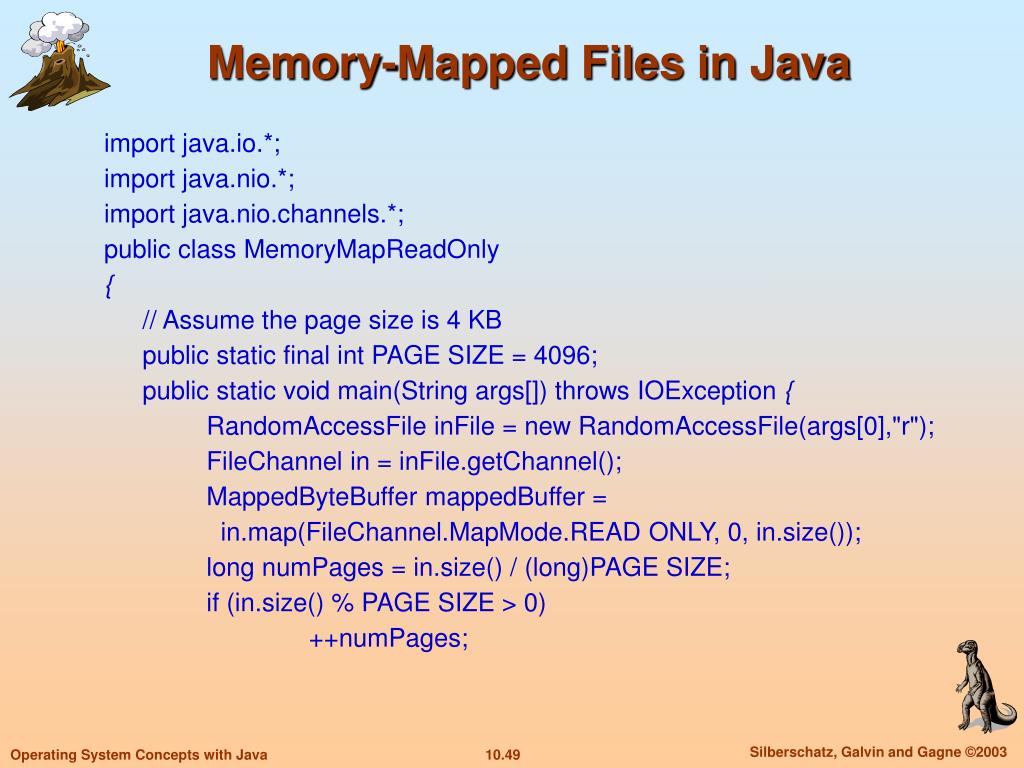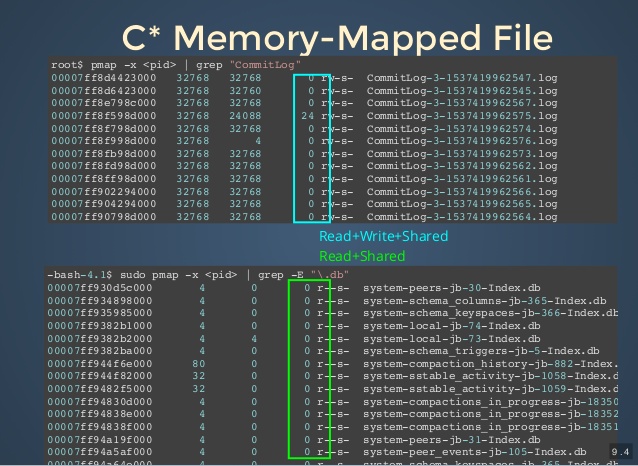Leveraging Memory-Mapped Files in Java: A Comprehensive Guide
Related Articles: Leveraging Memory-Mapped Files in Java: A Comprehensive Guide
Introduction
In this auspicious occasion, we are delighted to delve into the intriguing topic related to Leveraging Memory-Mapped Files in Java: A Comprehensive Guide. Let’s weave interesting information and offer fresh perspectives to the readers.
Table of Content
Leveraging Memory-Mapped Files in Java: A Comprehensive Guide

Java’s memory management system, while robust, often faces challenges when dealing with large files. Traditional file I/O methods, relying on byte-by-byte transfers, can lead to performance bottlenecks, especially when manipulating data spread across multiple disk blocks. This is where the power of memory-mapped files comes into play, offering a compelling solution for efficient file handling in Java.
Understanding Memory-Mapped Files
Memory-mapped files bridge the gap between the virtual memory space of a program and the physical storage of a file on disk. They allow a portion of a file to be mapped directly into the program’s memory, enabling the application to access and manipulate file data as if it were residing in RAM. This approach eliminates the need for explicit read/write operations, significantly accelerating file processing.
The Java API: java.nio.channels.FileChannel
The core component for working with memory-mapped files in Java is the java.nio.channels.FileChannel class. This class provides the foundation for interacting with file channels, offering methods like map() for establishing the mapping between a file and memory.
The map() Method: Establishing the Connection
The map() method serves as the gateway to memory-mapped files. It takes three parameters:
-
MapMode: Specifies the intended access mode for the mapped file. The available modes are:-
READ_ONLY: Allows only reading from the mapped file. -
READ_WRITE: Permits both reading and writing to the mapped file. -
PRIVATE: Enables private modifications to the mapped file, ensuring changes are not reflected in the original file on disk.
-
-
long position: Defines the starting position within the file from which the mapping should begin. -
long size: Specifies the length of the file region to be mapped into memory.
Example: Mapping a File for Reading
import java.io.File;
import java.io.IOException;
import java.io.RandomAccessFile;
import java.nio.ByteBuffer;
import java.nio.channels.FileChannel;
import java.nio.channels.FileChannel.MapMode;
public class MemoryMappedFileExample
public static void main(String[] args) throws IOException
File file = new File("my_file.txt");
RandomAccessFile raf = new RandomAccessFile(file, "r");
FileChannel channel = raf.getChannel();
// Map the entire file for reading
ByteBuffer buffer = channel.map(MapMode.READ_ONLY, 0, file.length());
// Read data from the mapped file
byte[] data = new byte[buffer.remaining()];
buffer.get(data);
// Process the data
System.out.println("File contents: " + new String(data));
channel.close();
raf.close();
This code snippet demonstrates the process of mapping a file for reading. It opens the file using RandomAccessFile, obtains its channel, and then maps the entire file into memory using READ_ONLY mode. The contents of the file are then read into a byte array and displayed on the console.
Advantages of Memory-Mapped Files
- Performance Enhancement: The direct mapping of file data into memory eliminates the overhead associated with traditional file I/O operations, resulting in significantly faster access and manipulation of large files.
- Simplified File Handling: Memory-mapped files simplify file processing by treating file data as if it were in memory, allowing for direct access and manipulation without the need for explicit read/write operations.
- Efficient Memory Management: By mapping only the required portion of a file, memory-mapped files reduce the memory footprint compared to loading the entire file into RAM.
- Data Consistency: Changes made to the mapped file are automatically reflected in the original file on disk, ensuring data consistency.
Considerations and Best Practices
- Memory Consumption: While memory-mapped files offer performance benefits, it’s crucial to consider the potential memory consumption. Mapping large files can exhaust available memory, leading to performance issues and even system crashes.
- File Locking: When multiple processes access the same memory-mapped file, it’s essential to implement appropriate file locking mechanisms to prevent data corruption or inconsistent states.
- File Size Limitations: The size of a memory-mapped file is constrained by the available virtual memory space. Attempting to map files exceeding this limit will result in errors.
-
Memory Allocation: Java’s garbage collector may reclaim memory occupied by memory-mapped files, potentially leading to unexpected behavior. Consider explicitly closing the
FileChannelto release resources and ensure proper cleanup.
FAQs
Q: What is the difference between memory-mapped files and traditional file I/O in Java?
A: Traditional file I/O in Java relies on byte-by-byte transfers between the application and the file on disk. This involves explicit read and write operations, which can be time-consuming for large files. Memory-mapped files, on the other hand, map a portion of the file directly into the program’s memory, allowing for direct access and manipulation of file data as if it were in RAM. This eliminates the need for explicit read/write operations, resulting in significant performance gains.
Q: When should I use memory-mapped files in Java?
A: Memory-mapped files are particularly beneficial for scenarios involving:
- Large File Processing: When dealing with files exceeding several megabytes, memory-mapped files can significantly improve performance by eliminating the overhead associated with traditional file I/O.
- Random Access: Memory-mapped files allow for efficient random access to file data, making them suitable for applications requiring frequent jumps within a file.
- Data Modification: For applications that modify file content, memory-mapped files provide a convenient and efficient approach for making changes directly in memory.
Q: Are there any limitations to using memory-mapped files in Java?
A: While memory-mapped files offer substantial advantages, it’s important to be aware of their limitations:
- Memory Consumption: Mapping large files can consume significant amounts of memory, potentially leading to performance issues or even system crashes if available memory is exhausted.
- File Locking: When multiple processes access the same memory-mapped file, proper file locking mechanisms are crucial to prevent data corruption or inconsistent states.
- File Size Limits: The size of a memory-mapped file is limited by the available virtual memory space. Attempting to map files exceeding this limit will result in errors.
Q: How can I ensure data consistency when using memory-mapped files?
A: Changes made to a memory-mapped file are automatically reflected in the original file on disk. However, it’s important to ensure that the changes are flushed to disk periodically, especially when dealing with large files or applications that require high data integrity. This can be achieved using the force() method of the FileChannel class.
Tips
- Optimize Memory Usage: When mapping files, consider mapping only the portion that is actively being used to minimize memory consumption.
- Implement File Locking: If multiple processes need to access the same memory-mapped file, implement appropriate file locking mechanisms to prevent data corruption or inconsistencies.
-
Flush Changes Regularly: Regularly use the
force()method of theFileChannelclass to ensure that changes made to the mapped file are written to disk, maintaining data consistency. -
Close Resources: Ensure that the
FileChanneland other resources associated with the memory-mapped file are properly closed to release resources and prevent memory leaks.
Conclusion
Memory-mapped files provide a powerful mechanism for efficient file handling in Java. They offer significant performance improvements by eliminating the overhead associated with traditional file I/O, enabling faster access and manipulation of large files. By understanding the advantages, considerations, and best practices, developers can effectively leverage memory-mapped files to enhance the performance and efficiency of their Java applications.








Closure
Thus, we hope this article has provided valuable insights into Leveraging Memory-Mapped Files in Java: A Comprehensive Guide. We appreciate your attention to our article. See you in our next article!